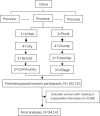Reproductive lifespan in association with risk of hypertension among Chinese postmenopausal women: Results from a large representative nationwide population
- PMID: 36003912
- PMCID: PMC9393301
- DOI: 10.3389/fcvm.2022.898608
Reproductive lifespan in association with risk of hypertension among Chinese postmenopausal women: Results from a large representative nationwide population
Abstract
Background: The association between reproductive lifespan and risk of hypertension among postmenopausal women is unclear.
Methods: A total of 94,141 postmenopausal women with a mean age of 64.8 years from the China Hypertension Survey were enrolled at baseline from 2012 to 2015. A standardized questionnaire was used to collect relevant information by well-trained interviewers. Blood pressure and physical examination of the participants were performed by trained medical staff. Logistic regression was used to estimate the odds ratios for hypertension by years of reproductive lifespan.
Results: The average years of reproductive lifespan in Chinese women was 34.0 years. Women who were longer in reproductive lifespan were more likely to have older age at recruitment, higher body mass index, larger waist circumference, lower mean systolic blood pressure, and higher mean diastolic blood pressure (p < 0.05). After adjustments, odds ratios (95% confidence interval) for hypertension were 1.035 (0.988-1.085), 1.007 (0.966-1.048), 1.000 (reference), 0.932 (0.899-0.967), and 0.953 (0.909-0.997) for those with reproductive lifespan at ≤ 28, 29-31, 32-34 (reference), 35-37, and ≥ 38 years, respectively, with a significantly inverse association was seen in those with reproductive lifespan at 35-37 and ≥ 38 years. The overall risk of hypertension declined with the increase in reproductive lifespan, and the risk of hypertension was reduced by 1.1% for every 1-year increase in the reproductive lifespan (odds ratio, 0.989; 95% confidence interval, 0985-0.994) per year. The negative association between reproductive lifespan and hypertension was evident among age at recruitment groups, body mass index categories, and education levels, with the strongest association among women aged ≥ 70 years. Positive associations between reproductive lifespan and risk of hypertension were evident among women aged < 60 years, and this association was stronger among current alcohol drinkers.
Conclusion: Based on the large nationally representative sample, Chinese postmenopausal women with a shorter reproductive lifespan have a higher risk of hypertension.
Keywords: CHS; Chinese Hypertension Survey; blood pressure; hypertension; postmenopausal women; reproductive lifespan; risk.
Copyright © 2022 Hu, Chen, Wang, Zhang, Chen, Zheng, Cao, Song, Zhou, Tian, Cai, Huang, Gu, Tian, Shao and Wang.
Conflict of interest statement
The authors declare that the research was conducted in the absence of any commercial or financial relationships that could be construed as a potential conflict of interest.
Figures



References
-
- Forouzanfar MH, Alexander L, Anderson HR, Bachman VF, Biryukov S, Brauer M, et al. Global, regional, and national comparative risk assessment of 79 behavioural, environmental and occupational, and metabolic risks or clusters of risks in 188 countries, 1990–2013: a systematic analysis for the global burden of disease study 2013. Lancet. (2015) 386:2287–323. - PMC - PubMed
-
- National Blood Pressure Sampling Survey Collaboration Group. Prevalence, awareness, treatment and control of hypertension in china: results of the 1991 sample survey. J Hyperten. (1995) S1:16–20.
LinkOut - more resources
Full Text Sources

